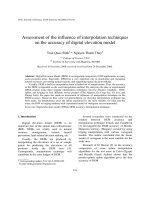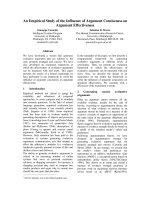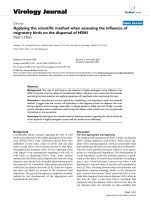The influence of perceived support on service providers organizational citizenship behavior a multi focal perspective
Bạn đang xem bản rút gọn của tài liệu. Xem và tải ngay bản đầy đủ của tài liệu tại đây (1.23 MB, 117 trang )
THE INFLUENCE OF PERCEIVED
SUPPORT ON SERVICE PROVIDERS’
ORGANIZATIONAL CITIZENSHIP
BEHAVIOR: A MULTI-FOCAL
PERSPECTIVE
HU ZHEHUA
National University of Singapore
2009
THE INFLUENCE OF PERCEIVED SUPPORT
ON SERVICE PROVIDERS’ ORGANIZATIONAL
CITIZENSHIP BEHAVIOR: A MULTI-FOCAL
PERSPECTIVE
HU ZHEHUA
(B.B.A. (XJTU, China), M. Mng. (XJTU,China ))
A THESIS SUBMITTED
FOR THE DEGREE OF DOCTOR OF PHILOSOPHY
DEPARTMENT OF MANAGEMENT AND ORGANIZATION
NATIONAL UNIVERSITY OF SINGAPORE
2009
ACKNOWLEDGEMENTS
I would like to express my deepest appreciation for the support, guidance and
assistance from my faculty, friends and family throughout the time I spent in my Ph.D.
study.
First and foremost, my sincere gratitude and my heartfelt thanks go out to my
supervisor, Associate Professor Daniel J. McAllister, for his invaluable advice,
guidance and encouragement. Thank him for the patience and helping to develop my
confidence as well as my skills. His thoughtfulness and critical suggestions
throughout the period made the tough journey enjoyable. His encouragement and
emotional support provided me confidence to finish this dissertation. Without his
tireless efforts and patience, the completion of this dissertation would not have been
possible.
I am also grateful to my ex-supervisor, Associate Professor Tan Hwee Hoon, for
her guidance in the creation of dissertation topic and ideas. She provided me rigorous
and constructive suggestions as well even after she left. She has been a wonderful
mentor and a good friend. I would like to express my appreciation to Associate
Professor Kowtha N Rao for his support and advices. I would also like to offer my
sincere thanks to Associate Professor Audrey Chia for serving on my dissertation
committee and offering detailed feedback. I would thank three examiners of my
dissertation for their valuable comments. My thanks also go to the administrative staff
of our department, Ms Sarah Chia, Ms
Lee Hoi Lam Helen, Ms Latifah Bte Wagiman;
Ms
Sally Han for their assistance in my study. They are always there for me in times
of need.
i
Especially, I am deeply indebted to Ms Lily Jee for her altruistic assistance in
my data collection. I would like to thank all staffs in two hotels of my data sources.
My beloved parents and family are also acknowledged with my deepest
gratitude and affection. Special thank is for my husband, Dr. Chu Junhong, for his
love, inspiration, and assistance in this tough journey. I would like to thank my
wonderful friends, Luo Min, Aegean Leung, Sankalp Chaturvedi, and Zhao Xiuxi for
their help and encouragement.
ii
TABLE OF CONTENTS
ACKNOWLEDGEMENTS
…………………………………… …………………….i
SUMMARY…………………………………………………… …………………… v
LIST of TABLES……….…………………………… ……………… ………… vi
LIST of FIGURES…………………………………………………………… … .vii
LIST of APPENDICES………… ……………… …… …………… viii
1 INTRODUCTION 1
1.1 SOCIAL EXCHANGE, PERCEIVED SUPPORT AND ORGANIZATIONAL CITIZENSHIP
BEHAVIOR
2
1.2 THE WAY TO UNDERSTAND SOCIAL EXCHANGE 4
1.3 CUSTOMERS AND THE SERVICE ECONOMY 6
1.4 RESEARCH QUESTIONS 7
1.5 DISSERTATION OVERVIEW 9
2 LITERATURE REVIEW AND HYPOTHESES DEVELOPMENT 10
2.1 CHAPTER INTRODUCTION 10
2.2 ORGANIZATIONAL CITIZENSHIP BEHAVIOR 10
2.2.1 Targets of Organizational Citizenship Behavior 10
2.2.2 Antecedents of OCB 12
2.2.3 Social Exchange Theory and OCB 13
2.2.4 Service Provider’s Exchange Relationships 15
2.3 SOCIAL SUPPORT THEORY AND OCB 16
2.4 MULTI-FOCAL PERCEIVED SUPPORT 17
2.4.1 Perceived Organizational Support 18
2.4.2 Perceived Supervisory Support 19
2.4.3 Perceived Coworkers Support 20
2.4.4 Perceived Customers Support 21
2.5 ORGANIZATION BASED SELF-ESTEEM AS MEDIATOR 23
2.6 RECIPROCATION WARINESS AS MODERATOR 26
3 RESEARCH METHODLOGY 30
3.1 CHAPTER INTRODUCTION 30
3.2 SUBJECTS AND DESIGN 30
3.2.1 Population and Samples 31
3.3 QUESTIONNAIRE DESIGN AND MEASURES 31
3.3.1 Focus group discussion 31
3.3.2 Measures 32
3.3.2.1 Independent Variables 32
3.3.2.2 Dependent Variables 34
3.3.2.3 Demographics and Control Variables 35
3.3.2.4 Questionnaire translation 35
3.4 HANDLING COMMON METHOD VARIANCE (CMV) 36
4 RESULTS 39
iii
4.1 CONFIRMATORY FACTOR ANALYSIS 39
4.2 CORRELATION AND RELIABILITY ANALYSES 40
4.3 TEST OF HYPOTHESES 41
4.3.1 Main Effect 41
4.3.2 Mediation Analysis 44
4.3.3 Moderation Analysis 46
4.3.4 Summary of Statistical Analysis of Multiple Regression 49
5 DISCUSSION 50
5.1 SUMMARY OF FINDINGS 50
5.2 SURPRISES? NO FINDINGS FOR POS; MAJOR FINDINGS FOR PCS 50
5.3 OBSE AS MEDIATOR 53
5.4 WARY INDIVIDUALS: STINGY OR CAUTIOUS? 54
5.5 CONTRIBUTIONS AND MANAGERIAL IMPLICATIONS 55
5.6 LIMITATIONS AND FUTURE RESEARCH DIRECTIONS 57
5.7 CONCLUSION 58
BIBLIOGRAPHY…………………………………………………………… .……60
TABLES.…………………………………………………………………….……… 69
FIGURES……….…………………………………………………………… … … 84
APPENDICES……….……………………………………………………….…… 87
iv
SUMMARY
Organizational citizenship behavior has been studied as an important antecedent
of organization effectiveness. This dissertation extends the multi-focal perspective on the
social exchanges of employees in organizations to include customers, and provides an
overall test of the linkage of perceived support to citizenship behavior within each of
four social exchange relationships—the relationships of employees with their employing
organizations, supervisors, co-workers, and customers. Within these social exchange
relationships, organization-based self-esteem is incorporated as a key mediating variable,
and reciprocation wariness is identified as a moderator. While past research has given
limited attention to the role of customers, a constituency outside of an employee’s
primary network of social relations, as a source of social support, the empirical findings
reported here highlight their strategic relevance. Theoretical and practical implications of
these findings are discussed.
v
LIST OF TABLES
Table 1 Measures 69
Table 2 Confirmatory Factor Analysis of Nested Models 72
Table 3 Correlation, Reliability and Descriptive Statistics 73
Table 4 Regression Analysis Results of Main Effects H1 74
Table 5 Regression Analysis Results of Main Effects H2 75
Table 6 Regression Analysis Results of Main Effects H3 76
Table 7 Regression Analysis Results of Main Effects H4 77
Table 8 Regression Analysis Results of Mediating Effects H5 78
Table 9 Regression Analysis Results of Mediating Effects H6 79
Table 10 Regression Analysis Results of Mediating Effects H7 80
Table 11 Regression Analysis Results of Mediating Effects H8 81
Table 12 Regression Analysis Results of Moderating Effects H9-H12 82
Table 13 Summary of Findings 83
vi
LIST OF FIGURES
Figure 1 Proposed model 84
Figure 2 Interaction between Reciprocation Wariness and OBSE in predicting OCB
directed towards supervisor 85
Figure 3 Interaction between Reciprocation Wariness and OBSE in predicting OCB
directed towards customer 86
vii
LIST OF APPENDICES
Appendix A Focus Group Discussion Guide 87
Appendix B Summary of Focus Group Discussion 90
Appendix C Questionnaire (English) 94
Appendix D Questionnaire (Chinese) 101
viii
1 Introduction
1 INTRODUCTION
Employees are often in situations that call for contributions beyond their formal
task requirements, and organizations stand to benefit when employees make these
contributions. Customers will be satisfied (even delighted) when employees go the
extra mile for service; supervisors and coworkers benefit when focal employees
contribute beyond the call of duty in their work; and organizations prosper. Although
these discretionary behaviors may not be included in the formal job description,
researchers have noted their significance in influencing managerial evaluations and
decisions (MacKenzie, Podsakoff, & Fetter, 1993; Podsakoff, MacKenzie, & Hui,
1993), and allowing organizations to function more effectively (Organ, 1988;
Podsakoff, Ahearne, & MacKenzie, 1997; Podsakoff & MacKenzie, 1994).
Given its clear organizational relevance, research on ‘extra mile’ contributions
in various forms—as organizational citizenship behavior (OCB) (e.g., Bateman &
Organ, 1983; Organ, 1988), extra-role behavior (e.g., Van Dyne, Cummings, &
McLean Parks, 1995), prosocial organizational behavior (POB) (Brief & Motowidlo,
1986; George, 1991), organizational spontaneity (George & Brief, 1992; George &
Jones, 1997), and contextual performance (Borman & Motowidlo, 1993; Borman &
Motowidlo, 1997; Borman, White, & Dorsey, 1995)—has become increasingly
prominent in the organizational behavior literature over the last two decades.
Scholarly work has been focused on various issues, including measurement issues and
motivational bases.
While there may be nuanced differences between the unique ‘above and
beyond’ constructs that have been introduced into the management literature, the
1
1 Introduction
extent of overlap is substantial. The focus of this dissertation is on the predominant
form of this behavior, Organizational citizenship behavior (OCB), which is formally
defined as individual behavior that is discretionary, not directly or explicitly
recognized by the formal reward system, and that in the aggregate promotes the
effective functioning of the organization (Organ, Podsakoff, & MacKenzie, 2006, p4).
1.1 SOCIAL EXCHANGE, PERCEIVED SUPPORT AND
ORGANIZATIONAL CITIZENSHIP BEHAVIOR
The concepts of social exchange (Blau, 1964) and the norm of reciprocity
(Gouldner, 1960) have long been used by organizational researchers to explain the
motivational basis behind employee behaviors and the formation of positive employee
attitudes. As one of the universal “principal components” of moral codes (Gouldner,
1960), the norm of reciprocity prescribes that “people should help those who have
helped them” (Gouldner, 1960:10) and that “people should not injure those who have
helped them” (Gouldner, 1960:10). While employees may have little control over the
formal aspects of their work (production lines may not be easily accelerated), they
often can contribute in discretionary ways in response to positive treatments. And
while employees may not want to reduce objective job performance as a response to
unsupportive or unfair treatment, they can balance the exchange relationship by
withholding OCB. Proceeding from the social exchange perspective on OCB, a
variety of indicators of positive treatment from organizations have been introduced,
including justice (Moorman, Blakely, & Niehoff, 1998; Tansky, 1993), exchange
quality (Settoon, Bennett, & Liden, 1996; Sparrowe & Liden, 2005; Wayne, Shore, &
Liden, 1997), and support (Moorman et al., 1998; Settoon et al., 1996; Wayne et al.,
1997).
2
1 Introduction
While early models of OCB were formulated in terms of a simple
employee-organization relationship, researchers generally agree that employees are
more discriminating, thinking “in terms of relationships with associates, immediate
superior, the immediate work unit, and various other dimensions of their membership
and attachment” (Organ, 1990. p.66). In discussing the relationship of treatment
fairness and OCB, Organ observes that “employees form various social exchanges
and may discriminate more fairness in some of these relationships from less fairness
in others. The implication of such distinctions is that a particular locus of perceived
unfairness will affect OCB in some context rather than necessarily in a gross or
generalized fashion” (Organ, 1990. p.66).
The recent trend within the organizational justice, social exchange and OCB
literatures has been to acknowledge the multi-focal nature of these constructs (Lavelle,
Rupp, & Brockner, 2007). In the late 1990s, justice researchers began arguing that it
may be beneficial to consider the sources of justice since several distinct foci of
justice are possible (Rupp & Cropanzano, 2002). Coming to perceived support,
researchers have examined support perceptions pertaining to supervisors, coworkers,
and organizations as a whole. Finally, OCB researchers have been interested in
citizenship behavior directed towards distinct targets for a long time (Williams &
Anderson, 1991), and have found it useful separate OCB directed towards
organizations from OCB directed towards supervisor and OCB directed towards
coworkers (Rupp et al., 2002; Settoon & Mossholder, 2002).
However, when considering the effect of perceived support on OCB, few
studies have incorporated more than two foci or targets. This dissertation provides a
robust examination of the support to citizenship behavior relationship within four
3
1 Introduction
distinct exchanges—with the organization, supervisor, coworkers and customers. This
dissertation examines the distinctiveness of those relationships, and explores the
effect of perceived support on citizenship behavior inside each exchange.
1.2 THE WAY TO UNDERSTAND SOCIAL EXCHANGE
Relative to the substantial body of research documenting the relationship
between POS and OCB (e.g., Moorman et al., 1998; Settoon et al., 1996), “less
attention has been given to the mechanisms presumed to underlie the positive
relationship between POS and work-related outcomes” (Armeli, Eisenberger, Fasolo,
& Lynch, 1998. p.289). Moreover, the basic concepts underlying social exchange
theory have not been fully identified, and few studies directly examine the “black
box” of the exchange process (Cropanzano & Mitchell, 2005).
Identifying the psychological constructs that mediate between perception
(perceived support) and behavior (OCB) could help us better understand the social
exchange dynamics that links support and OCB (Rhoades & Eisenberger, 2002). To
date, only a few studies have examined potential mediators. Eisenberger, Armeli,
Rexwinkel, Lynch, and Rhoades (2001) found that felt obligation and positive mood
mediate relationship between POS and organizational spontaneity. In another study
conducted in China, Chen, Aryee and Lee’s (2005) found that trust in organization
(TIO) and organization-based self-esteem (OBSE) partially mediated the positive
relationship between POS and OCB. While various psychological concepts could
potentially serve as mediators, the esteem-enhancing potential of organizational
support has been discussed at length in the organizational support literature (Armeli,
Eisenberger, Fasolo & Lynch, 1998; Eisenberger, Huntington, Hutchison, & Sowa,
1986; Rhoades, Eisenberger & Armeli, 2001), and is closely examined in this
4
1 Introduction
dissertation. Importantly, while the principal focus of attention in the organizational
support literature has been on the esteem-enhancing potential or organizational
support in particular, I consider the potential for support from multiple sources to
enhance the self-esteem of employees.
From the standpoint of multiple social exchange relationships, it is important to
bear in mind the alignment between sources of support and citizenship behavior
targets that social exchange theory suggests. Within social exchange theory, the term
“exchange relationship” refers to an association between two interacting partners
(whether individuals or institutions) (Cropanzano et al., 2005). For employees, their
social exchange relationships with their supervisors (e.g.,Wayne et al., 1997),
organizations (e.g., Chen et al., 2005; Moorman et al., 1998) and coworkers (e.g.,
Flynn, 2003) (e.g., Flynn, 2003) are each considered somewhat separate and distinct.
In line with the norm of reciprocity, employees can be predicted to maintain balance
between the support they receive from each of these social exchange partners and the
help they provide in exchange (Masterson, Lewis, Goldman, & Taylor, 2000). This is
precisely the prediction of Lavelle’s target similarly model (Lavelle et al. (2007).
Although perceived support is mostly regarded as positive and linked to positive
individual or organizational outcomes, the consequences of perceived support may
vary. Research on social exchange shows that employees treated similarly by an
organization may have different beliefs about their OCB obligations because
individual differences may differentially sensitize them to certain aspects of the
treatment they receive (Kamdar, McAllister, & Turban, 2006). For research on the
dynamics of social exchange relationships, it would seem that acceptance of and
adherence to the norms of social exchange (e.g., exchange ideology, norm or
5
1 Introduction
reciprocity acceptance, reciprocation wariness) would be particularly crucial.
Consistent with this understanding, researchers have found that individual exchange
ideology moderates the relationships between organizational support scores and
ratings of OCBs (Witt, 1991). In the present study, reciprocation wariness is
examined as a representative social exchange-related individual difference that
moderates the relationships of perceived support and citizenship behavior.
1.3 CUSTOMERS AND THE SERVICE ECONOMY
Across the globe, the economic center of gravity is shifting from manufacturing
goods to the creation and sale of services. One important characteristic of service
organizations that distinguishes them from manufacturing organizations is that, as a
part of service delivery, customers perform co-production behaviors in order to
complete the service delivery (Bowen & Waldman, 1999; Lengnick-Hall, 1996).
Actually, the service delivery process consists of the cooperation of service providers,
organization, coworkers, supervisor and customers. The frequent interactions between
service providers with other parties embedded in service delivery process form an
interaction network of service.
Findings in the marketing area reinforce the position that the quality of
interpersonal contact is a critical factor in the quality of service encounters (Adelman,
Ahuvia, & Goodwin, 1994; Solomon, Surprenant, Czepiel, & Gutman, 1985). Despite
the strategic significance of customers as an organizational constituency, and the fact
that the quality of employee-customer relationships is a key determinant of service
delivery effectiveness, we know little about the dynamics of social exchange between
employees and customers. Interestingly enough, while Chester Barnard (1938)
included customers as essentially part of organization, customers have been studied
6
1 Introduction
less than supervisors, coworkers or the organization. As active participants in the
organization, customers form exchange relationship with employees too. However,
relative to the relationships with other constituencies, the relationship between
employees and customers as a form of generalized reciprocity (Gouldner, 1960), has
not been given much attention in organization behavior field. A multi-focal
perspective on support and OCB must incorporate the customer.
Moreover, although the beneficiary is “outside” the organization, OCB directed
towards customers is valuable and contributes a lot to organizational effectiveness.
When I examine the effect of support on OCB in service context, customers will be an
indispensable party to complete the whole picture of service provider’s exchange
relationships.
1.4 RESEARCH QUESTIONS
The objective of this dissertation is to understand the effect of perceived support
on OCB from a multi-focal perspective in the service context. I examine the effects of
perceived support from four sources—perceived organizational support (POS),
perceived supervisory support (PSS), perceived coworkers support (PWS) and
perceived customers support (PCS)—on citizenship towards four targets—OCB
directed towards organizations (OCBO), OCB directed towards supervisor (OCBS),
OCB directed towards coworkers (OCBW) and OCB directed towards customers
(OCBC).
The issues addressed in this dissertation are succinctly encapsulated in three
questions, as follows:
7
1 Introduction
1. Does support matter? What role does perceived support from multiple
sources in workplace play in predicting a service provider’s OCB
directed towards multiple targets, respectively?
2. How does support matter? What are the mechanisms by which perceived
support from multiple sources in workplace influence OCB directed
towards multiple targets?
3. Under what conditions does support matter? What is the effect of
individual difference on the relationship between perceived support and
OCB?
To answer these questions, I first examined the extent to which service
provider’s OCB is influenced by perceived support in workplace. Secondly, I
examined how perceived support affects OCB, with a particular focus on the role of
organization based self-esteem as a mediator. Thirdly, I examined the moderating
effect of reciprocation wariness on the linkage between organization-based self
esteem on OCB.
By adopting a multi-focal perspective, this study extends our understanding of
the antecedents, as well as our understanding of how to classify OCB. By considering
customers as a support source as well as an OCB target, this dissertation brings into
focus the importance of exchange relationships beyond employee’s primary networks.
This dissertation also enriches our understanding of support from different sources,
which will help organizations to increase the prevalence of OCB and thus increase
their effectiveness.
8
1 Introduction
1.5 DISSERTATION OVERVIEW
Subsequent chapters in this dissertation proceeds as follows: Chapter 2 provides
a review of past research surrounding all constructs examined in this study, based on
which the research model for this study will be presented and the hypotheses to be
tested will be outlined. Chapter 3 outlines the methodology and data collection of the
study. Chapter 4 presents results of the study. Chapter 5 discusses the results and the
conclusions, limitations and implications of the study.
9
2 Literature Review and Hypotheses Development
2 LITERATURE REVIEW AND HYPOTHESES
DEVELOPMENT
2.1 CHAPTER INTRODUCTION
This chapter presents an overview of the research streams under investigation in
this dissertation. The areas of OCB, perceived support, and social exchange are discussed
in service context. Briefly, it is proposed that perceived support in workplace influences
employees’ OCB through Organization based self-esteem. Based on this, this chapter will
present the research model (Figure 1) that integrates these constructs. Descriptions of the
constructs in the research model will be provided and research hypotheses will be
specified.
Insert Figure 1 about here
2.2 ORGANIZATIONAL CITIZENSHIP BEHAVIOR
2.2.1 Targets of Organizational Citizenship Behavior
Research on OCB now spans several decades. While there has been much debate
and controversy over the dimensionality of OCB, considerable consensus has emerged on
the fact that OCB can be targeted towards specific constituencies. Smith, Organ, and
Near (1983) introduced two dimensions of OCB—altruism, which was targeted towards
10
2 Literature Review and Hypotheses Development
specific people, and conscientiousness, which was targeted towards the organization. Not
long after, Williams and Anderson (1991) made this distinction among OCB constructs
explicit, referring to these constructs as OCB directed towards individuals (OCBI) and
OCB directed towards organizations (OCBO). Similarly, Coleman and Borman (2000)
suggested three categories of behavior that vary with respect to the behaviors’ beneficiary.
This typology can be broadened further with consideration of the customer as a target of
OCB.
Research suggests that OCB of contact employees plays a significant role in
determining customer satisfaction with service encounters (Bitner, Booms, & Tetreault,
1990). Morrison (1996) developed a model that links human resource practices and
service-oriented citizenship behavior to service quality. Vaughan and Renn (1999) argued
that customer service citizenship behavior (CSBC) performed by frontline employees is a
unique form of OCB that is conceptually distinct from other forms of OCB. Their
proposed framework linked CSBC and customer loyalty with perceptions of service
quality (Vaughan et al., 1999). Findings reported by Hui et al. (2001) have confirmed a
link between service-oriented OCB and service quality (Bettencourt & Brown, 1997).
The importance of distinguishing OCB by behavior target becomes apparent when
we appreciate the diversity of exchange relationships that exist—between the employee
and the organization, between the employee and the supervisor, between the employee
and coworkers, and between the employee and customers. Individuals can have better
exchange quality in some of these relationships than in others. For example, employees
who do not have positive feelings toward the organization may be unlikely to perform
11
2 Literature Review and Hypotheses Development
OCBO. However, these same individuals may have positive relationship with their
coworkers and help them.
In this dissertation, extending Williams and Anderson’s (1991) 2-dimension
framework and Coleman and Borman’s (2000) 3-dimension framework, four distinct
targets of the citizenship behavior will be considered. The three person-directed OCB
recipients are supervisors (OCBS), coworkers (OCBW) and customers (OCBC). The
final OCB target is the organization itself (OCBO).
2.2.2 Antecedents of OCB
Past empirical research has been focused on four major categories of antecedents of
OCB (Podsakoff, MacKenzie, Paine, & Bachrach, 2000), including individual (or
employee) attitudinal and dispositional factors (Bateman et al., 1983; Organ, 1988), task
characteristics (Podsakoff, MacKenzie, & Bommer, 1996), organizational characteristics
(Moorman et al., 1998), and leadership behaviors (Podsakoff et al., 1996; Podsakoff,
MacKenzie, Moorman, & Fetter, 1990). However, while variables from these categories
may provide good explanation for citizenship behaviors in general, they have limited
value in explaining OCB directed toward different targets (Korsgaard, Meglino, & Lester,
1997). A relational or social network perspective assumes that an individual’s behavior is
not driven solely by his/her personal disposition or attitudes. Instead, the interpersonal
relationship affects the attitudes and behaviors of individual (Scott, 2000).
The premise guiding this research is that people are likely to match the level of
their helpfulness to others with the level of support they receive within specific social
12
2 Literature Review and Hypotheses Development
exchange relationships. As Anderson and Williams (1996) suggested, individually
focused OCB processes can be understood “by using a dyadic (relationship) framework”
(p. 293). Rhoades and Eisenberger’s (2002) meta-analytic findings indicate that POS is a
better predictor of organizationally directed than of individually-directed citizenship
behavior. Rhoades and Eisenberger (2002) and Lavelle et al. (2005) also highlight the
importance of aligning the foci of both independent and dependent variables. Lavelle et al.
(2007) suggested that multifoci social exchange predicts multifoci citizenship behavior.
Shifting the focus from characteristics variables to the variables determining relationship,
this dissertation tries to explore the effect of supportive relationships on OCB.
2.2.3 Social Exchange Theory and OCB
Relationships among people can be distinguished based on social and economic
exchange, in the manner described by Blau (1964). Economic exchange has a contractual
character; the respective parties agree in terms of specific conditions, over an articulated
domain of behavior and for a precise time-span. The respective obligations are finite and
do not depend on trust. The very nature of economic exchange tends to limit itself to
commodities that have objective or impersonal value independently of the identity of the
parties to the exchange. Social exchange, by contrast, involves diffuse, unspecific
obligations in terms of the nature, value, and timing of the benefits render and received
by the parties. For example, expressions of positive regard in the form of support create a
feeling of indebtedness and a corresponding obligation to reciprocate. Similarly,
receiving or giving social support, under the norm of reciprocity, helps to build a
supportive relationship among people. Because of its volitional nature, citizenship
13
2 Literature Review and Hypotheses Development
behavior provides a means of fulfilling this obligation and reinforcing a general belief in
the intrinsic value of the exchange relationship.
The two main ways social exchange has been conceptualized in the management
literature are as a global exchange relationship between employees and the organization
and as a more focused, dyadic relationship between subordinates and their supervisors. At
the global level, Eisenberger, Huntington, Hutchison, and Sowa (1986) suggested that
employees form a global belief concerning the extent to which the organization values
their contributions and cares about their well-being, which is labeled perceived
organizational support (POS). Exchanges between the employee and his/her supervisor
are referred to as leader-member exchange (LMX) (Graen & Scandura, 1987).
Perceived organizational support has long been conceptualized in social exchange
terms (Eisenberger, Fasolo, & Davis-LaMastro, 1990; Eisenberger et al., 1986). The
effect of POS often is explained in reciprocal terms—an employee who sees the
employer as supportive is likely to return the favor. High levels of POS are thought to
create obligations within individuals to repay the organization. When POS is high,
workers are (undersome conditions) more likely to engage in OCB (Lynch, Eisenberger,
& Armeli, 1999), higher job performance (Eisenberger et al., 2001) and reduced
absenteeism (Eisenberger et al., 1986). In this way, researchers have often conceptualized
POS as the “quality” of the social exchange that takes place between an employee and the
employer as a whole. Furthermore, POS is associated with a trust that the organization
will fulfill its exchange obligations (e.g., rewarding employees).
14
2 Literature Review and Hypotheses Development
Social exchange has also been used to explain why subordinates become obligated
to their supervisors to perform in ways beyond what is required of them in the formal
employment contract. Research on leader-member exchange (LMX) has shown that an
interpersonal relationship evolves between supervisors and subordinates against the
background of a formal organization (Graen, 1975).There is variance among subordinates
in the frequency with which they engage in activities that extend beyond the employment
contract (Liden & Graen, 1980; Wayne et al., 1997). For example, Tansky (1993) found a
positive relationship between the quality of supervisor/subordinate relationship and OCB,
suggesting that when employees perceive a good relationship with their supervisors they
feel they are getting benefits not specifically outlined in their economic exchange with
the organization, and they are more willing to reciprocate with OCBs.
2.2.4 Service Provider’s Exchange Relationships
In the workplace, employees can form social exchange relationships not only with
their supervisors (e.g.,Wayne et al., 1997), organizations (e.g., Chen et al., 2005;
Moorman et al., 1998) and coworkers (e.g., Flynn, 2003), but also with customers. Indeed,
the quality of the exchange relationship between service providers and customers is likely
to have strategic significance because personal interaction between service providers and
customers is at the heart of most services (Kelley, Donnelly, & Skinner, 1990; Surprenant
& Michael, 1987; Zeithamil & Bitner, 2000).
In contrast with the dyadic exchange relationships that employees have with their
supervisors and coworkers, which are person-specific, relatively stable and lasting, the
exchange relationships between service providers and customers are unstable and mostly
15









